"Progress" at Home Close Hole, September 2008 - January 2009
or 'per ardua ad nauseam'
by Tony Audsley
Belfry Bulletin 534, 57(2), Spring 2010, p7-11 (Note - page breaks here are arbitary)
Well, it depends what you mean by progress! If you are looking for tales of massive spoil removal and shaft sinking records, then stop reading now. On the other hand, as there are nearly 100 entries in the digging log, something must have been happening. So just what has been going on?
To regress a little, the first phase of digging at this site was the subject of J-Rat's last digging article (BB 531 p28-30). It was a 'JCB' style excavation which took place between 21st and 25th August 2008. By the 23"1 August, the excavation was 10 metres deep and had exposed part of an East- West trending rift, with a rock wall clearly visible on the north. The Western end of the rift was also visible in the pit. But now we come to the tragic bit...
We never actually saw the rock wall on the South, although we could hear the teeth of the excavator bucket scraping against what sounded like solid rock. The problem was that the Hitachi Zaxis was working from the southern side, perched on a tottering pile of stuff at the edge of the hole and every time that Mark Crook tried to clear the wall directly below, more material dropped from under his tracks as the excavator threatened to nose-dive into the pit.
In an ideal world, it would have been nice to have gone deeper, to try to find a decent seating for a shaft; but this would have meant moving tons of spoil to create another working bench. It was not possible. So, we were left with two alternatives, to back fill and forget about it, or install a concrete ring shaft sitting on the semi-liquid goo at the bottom of the pit and hope that we would be able to stabilise it later. This sounded like it might be good fun and anyway, backfilling was a waste of a perfectly good hole and so never really an option.
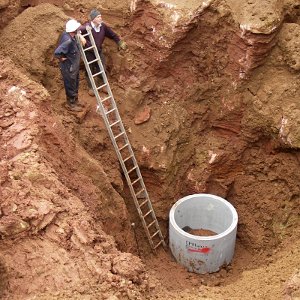
Above:- Rift looking North-West, the first ring in position. Dave Speed and Jim Young at the top
That was the end of phase one. The pit was back filled and the depression was restored pretty much to its original profile, but now it had a 10 metre concrete pipe shaft in the north-west. The shaft was sitting on mud, with a solid rock wall 60 - 70cm away to the North and maybe a metre away to the South. Before digging could begin in earnest we realised that three tasks would have to be done:-
1) The site needed fencing.
2) The rings needed locking together to prevent the shaft distorting.
3) The base of the shaft needed supporting, ideally by drilling into the rock walls and casting reinforced concrete seatings.
Unfortunately, there was also a fourth task which needed to be done, but we didn't realise this for quite some time.
The First Task, The Fencing
Work started on this on 18th September 2008. The digging log has this to say on the subject:- "Over to the depression and found a small lake in front of the shaft. A lot of water had drained from this previously and scoured out a channel to the shaft and washed out material from round the top of the shaft... Chatted to Bridget [Perkins] who said she had been over to the depression when it was raining hard and had heard a lot of water falling down the shaft... Staked out a possible fence line. Bigger than I would have wished but it is not possible to set posts in the thick mud around the pond. "
The fence was put up in the week 22nd to 26th September. The log goes on rather tediously about the pool, the sunshine and the dancing dragonflies. Not much else to say about the fencing unless anyone has a prurient interest in burst blisters - (there are photographs) [Ed. Definition of Prurient is - 'having or showing excessive interest in sexual matters' - ref. Oxford Advanced Learners Dictionary 1989:1006].
The Second Task, Locking the Rings
This started with the purchase of six five metre lengths of 50mm x 6mm steel strip from Avon Steel. These were delivered to the farm at 16:30 on 3rd October 2008. They were cut and welded into three 10 metre lengths the same evening and then towed over to the hole the following morning, getting back just in time for the AGM at the Belfry.
The original intention was to drop these straps down the shaft and drill and bolt them (using thunderbolts) to the rings. However, the idea of drilling lots of holes into the concrete pipes generated a certain amount of unease and the idea was shelved in the hope that a better one would surface.
While waiting for inspiration regarding the straps, it seemed a good idea sort out some ladder, so back to Avon Steel for five lengths of 40x8mm flat and three lengths of 12mm bright round bar, more than enough to make 10 metres of fixed ladder. Interestingly, the material costs of the ladder was less than the price of 10 metres of commercial wire ladder. Making the ladder took a while (13-17 October 2008), but quite a bit of this was making the necessary jigs and bits and pieces to aid production. Hopefully, making the next 10 metres will be much quicker.
On Wednesday 22nd October, Henry Bennett did most of the work in bolting the sections together and then lowering the ladder down the shaft and fixing the top belay. The following Wednesday evening Pete Hellier, Henry Bennett and I set up the old Rose Cottage tripod over the shaft. Pete went down to inspect the bottom of the shaft and found six inches of standing water.
The Winter of 2008 arrived, but the inspiration hadn't, so the time was spent on what might be described as displacement activities. A stile was made out of scaffolding. This is intended to be multifunctional, a sawing bench, a device for bending and forming reebar and it can also be used for getting over the fence. Quantities of timber were acquired, thanks to Trevor Hughes and Stuart Lindsay; quantities of steel were acquired, thanks to Ivan Sandford, Tim Large and Jeff Price.
It is said that in Spring a young man's fancy lightly turns to thoughts of... Damn, can't remember. Anyway, mine turned to bottle-jacks. Behind the Belfry, buried in the mud and rusted solid, but beautiful none the less were some 5 ton jacks, the sort of things that could be used to hold bridges together, or possibly crane jibs or... CONCRETE RINGS. Got it! All that was needed was to get them home, squirt some oil, free them up, twist the straps round them, tighten them up and hey presto, job done.
That's the theory, the practice was more or less the same, it just took rather longer and involved quite a lot of propane gas as well. The jacks were really rusted solid and as their threads were 38mm diameter, they did take a bit of freeing, (the most difficult one took 12 hours over two days).
By the end of March, there were three working jacks and at the beginning of April I evicted Nigel Perkins from his workshop at Wigmore Farm and then proceeded to empty his oxygen and acetylene bottles (thanks, Nigel) while indulging in amateur blacksmithing. The end result of this was three long straps which hooked over the top of the shaft and dangled down with eyes at the bottom end to attach the jacks; and three shorter straps to do the same sort of thing (only upside down) at the bottom of the shaft.
On Monday 13th April, the upper straps were dangled down the shaft, (they were surprisingly musical when struck) and Tim, Jeff and I tried to fit the bottom straps and the jacks. We did manage to fit one and in the process actually did some digging. Ten skip loads were removed. On the following Wednesday evening, the same team continued excavating at the bottom of the shaft while trying to fit the last two jacks and bottom straps. All were fitted but we then found that the third jack had jammed again. It was removed for more fettling. Another ten skip loads came up the shaft this evening. Sunday morning 19th April saw the three of us plus Duncan Butler over at t'hole. I went down and fitted the last jack and managed to dig out 9 skip loads. Duncan then went down and dug out a further 6.
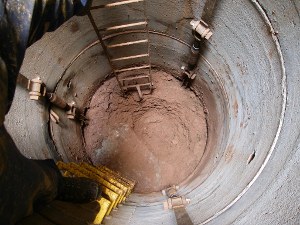
Above:- Shaft bottom with the straps and jacks
The Third Task, Supporting the Concrete Rings
We thought that this was going to take a LOT of concrete, so on the 4th June 2009, we took delivery of 10 tons (or possibly 10 tonnes) of what used to be called 'three quarters to dust', but which the quarry's computer now calls 'Crushd Fin Agg (20mm - Dst)'. Doesn't roll off the tongue so well, but that's computers for you.
Enough of that, back to the third task. The idea behind this, as ever, is a simple one. All one needs to do is to excavate a sector of fill under the rings, tunnel out to find the rock wall behind, clean it off, drill a few holes in it, stick some artistically bent reebar in, then fill the whole lot with concrete. Move to the left and repeat as often as necessary.
Sounds good to me and I guess it would work, provided that the clag behind the shaft behaves itself and stays put while all this is going on.
Provided? Not a problem. I had done this before at Fernhill (see BB 531 p24-26). It's easy, all that is necessary is to drill horizontally into the rock wall, put in a few lengths of reebar and use these to support the fill. Once this is supported it's possible to tunnel underneath and do the rest of the work.
So what happened? On Sunday afternoon, 14th June 2009 a team of Alice Audsley, Chris Batstone, Tim Large and I took over our new generator (thanks to Jeff) over to the hole. I went down the shaft and drilled into the wall, while the rest of the party built a sandbag wall round the heap of aggregate to stop it sliding into the pond. The wall building went rather better than the drilling as the drill kept jamming in the guide. Only two holes were completed. Due to the difficulties caused by the drill jamming we tried, on the 3rd July, hammering pointed lengths of rebar into the relatively soft rock wall and then supporting the shaft end of the bars with metal clamps. This was a bit of an act of desperation brought on by the fact that Annie and Roger were due to get married in Scotland on 24th July and I was keen to get some concrete in position before then. So, we reckoned that if we could dig out a sector of fill on Wednesday, then we could drill, clean up, reebar and concrete on the following weekend.
In preparation for the cleaning up, I went over to the hole on 6th July and installed a water pipe down the shaft with a tap at the bottom and a header tank on the surface. This was intended to enable the exposed rock wall to be pressure washed prior to concreting. More on this later.
On Wednesday 15th July, Henry Dawson, Jeff Price, John Noble, Paul Brock and I set to work. Paul did most of the digging and John did most of the hauling. Nine loads, one rock and one frog were hauled up the shaft. Strictly speaking, the frog travelled up the shaft inside John's oversuit; when he got to the surface, it took quite a while to get the frog out as it seemed to have formed a strong emotional attachment to John's armpit. Meanwhile, Paul exposed an area of rock wall 60 x 60 cm sufficient to cast a decent plug of concrete after cleaning and drilling. Later, Henry and I went down to test the washing system. At first this produced only a pathetic dribble of water despite much furtling underground and on the surface. Finally the joint between the tap and the downpipe was disconnected and the tap and the bottom of the pipe were found to be stuffed with small green leaf fragments. The hose pipe had been sitting at the dig for most of the year and a leaf-cutter bee had made its home in it. Once this blockage had been removed, water sprayed everywhere. Henry was OK, he was part way up the ladder, but he almost fell off laughing.
On Friday, it rained hard all day and a 'pre-cementing' inspection found that the pond was full and that water was pouring down and around the shaft. It was certainly going to be too wet to attempt cementing at the weekend.
The next day, Chris Batstone, Stuart Lindsay and I went over to the hole with the intention of filling Paul's excavation with bags to prevent the fill above from collapsing into it. Unfortunately, the fill had beaten us to it and wiped out Paul's work very neatly. Most of the reebar shoring had held up, but mud had sludged between the supports and rocks had moved down from the unsupported (western) side of the excavation.
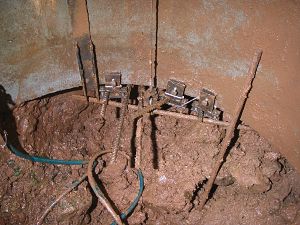
Above: - Collapse at the bottom of the shaft.
T'hole: 1, Diggers: 0! A reverse digging session then ensued. Five bags of spoil were lowered down the shaft and jammed in, round and under to prevent further collapse. Back to the surface for pies and bread pudding, provided by Stu. This was followed by a silly afternoon session, nominally with the intention of draining the pond. The three of us staggered about in the slime in the centre of the depression, sank a digging bucket and then siphoned water from here to the bottom of the shaft. This was successful, but a few days later, the pond had reformed and the syphon of course, did not restart itself.
24th Ju|y, Wedding Stopped Play
By this time, it had become obvious that something would have to be done about the water sinking round the outside of the shaft. Back in August 2008, when the depression was being backfilled and restored, the surface was effectively lined with compacted clay. Since September that year, there had always been a pond at the bottom of the depression; even in the summer. When it rained, the water level rose, the pond overflowed and drained around the outside of the concrete rings.
And so we come to the fourth task:- [By the way, did you know that printers used to refer to a colon and hyphen :- as the dog's bollocks?]
Drain the pond and pipe the water down the inside of the shaft to below the base of the concrete rings.
The Fourth Task, Draining the Pool
On 2nd August 2009, Alice Audsley, Annie Audsley (GSG, newly married but not changing her name), Roger Galloway (GSG) and I took coils of 25mm polythene water pipe to the hole. We spent a pleasant day digging a trench at the level of the bottom of the first ring from the shaft to the centre of the depression, where a bucket was sunk to act as a drainage sump. Roger drilled two 60mm holes at the bottom of the first ring. Then two water pipes were run up from the bottom of the shaft, through the ring, along the trench and poked through holes in the side of the bucket. The pond then drained with a most impressive slurping noise. There has not been standing water in the depression since then.
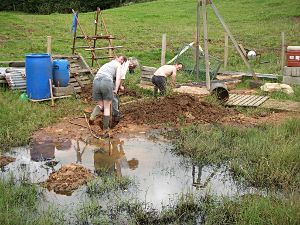
Annie Audsley, Alice Audsley and Roger Galloway digging the drainage trench
So far, so good, but then another distraction. Annie and Roger had a second wedding celebration, planned for 5th September. The first part of this ceremony involved getting 90 people into our garden and house. Problem! The garden was full of all sorts of stuff that might come in useful at The Hole and the house was full of dead computers. It took a lot of clearing and I am ashamed to say that some things actually went to the tip. So that was the rest of August gone. I guess it was all worth it if only to see the wedding cake, made by Norman Flux (inventor of the Rana Hole Fluxcavator V). Norman intended the cake to be cut using plugs and feathers, which came pre- installed. This was not entirely successful, but he had thoughtfully provided a backup lump hammer and bolster chisel, which was very effective.
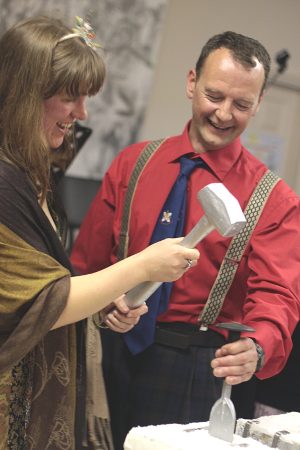
Annie cuts the wedding cake.
Since then, there has not been a lot to report, our house and garden have been restored to their pre-wedding state, which took about a month. Over at the hole, the rock wall has been probed and more holes drilled for reebar shoring. Also someone, who shall remain nameless had the stupid idea of making a device to inject a dry 3:1 mix of sand:cement directly into the fill using compressed air. Don't try this without a respirator. No, just don't try it at all.
The current situation at the dig is that we need better weather for a major cementing effort and pending that, we are building a decent site-hut, although as I write this the timber for the hut is under six inches of snow. So that's the story to date; quite a lot of effort, not much spoil. In fact quite a lot of our spoil was pinched from Caine Hill anyway; an underhand trick if ever there was one. To be fair, we are using the rock taken from Caine Hill to build the foundations of the new digging hut. Viewed coldly, all this might be regarded as faffing, on the other hand, a more charitable view could be that this is all useful development work which will pay dividends in the future. The French have an expression, which unfortunately they say in French so no-one understands, but which I gather goes something like "step back in order to leap". That's our excuse and we are sticking to it.
Diggers and Helpers:
Alice Audsley, Annie Audsley, Chris Batstone, Duncan Butler, Henry Bennett, Henry Dawson, Ivan Sandford, Jeff Price, John Noble, Nigel Perkins, Paul Brock, Pete Hellier, Pete Page, Roger Galloway, Stuart Lindsay, Tim Large, Tony Audsley, Trevor Hughes.
Created: Tue Apr 3 10:41:21 2012
Revised: